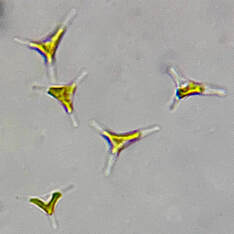|
For over six years we have provided our customers with a top-quality live phytoplankton feed. REEFreshments: Live Phytoplankton has become a staple for aquarists all over the United States. The positive feedback and success stories that we receive from aquarists dosing our phytoplankton is the best reward we could ask for, and it fuels our passion to continue producing live feeds at the highest standards of quality and excellence. While our REEFreshments: Live Phytoplankton blend is tried and true, we are constantly looking for ways to improve our products and make sure that we continue to provide aquarists with superior live feed blends. With that as our mission, we are excited to announce a refined REEFreshments: Live Phytoplankton recipe that now contains an extra specie of phytoplankton, making our phyto now a 5-specie blend!
Why We Decided to Refine our Phyto Recipe Let me start by saying, we did not take revising our phytoplankton blend lightly. The decision to add Phaeodactylum to our REEFreshments blend was only made after much research on this particular species of microalgae. This research included: An extensive review of the literature on Phaeodactylum, experimentation with culturing this microalgae in our Phyto Lab at Aquaholic Aquaculture, and regular dosing of Phaeodactylum in our own coral systems at Aquaholic as well as in beta-tester reef aquariums over the course of the last year. Our research and experiments have concluded the following: Phaeodactylum is a unique, nutritious, and hardy microalgae that deserves a place alongside our core microalgae strains that comprise our REEFreshments phytoplankton blend. The addition of Phaeodactylum to our REEFreshments: Live Phytoplankton only makes our blend BETTER! We are in LOVE with Phaeodactylum and are beyond excited to be introducing it as our new 5th core phyto strain! The Short and Sweet of Why We LOVE Phaeodactylum 1. Highly Nutritious – Phaeodactylum boasts an excellent nutritional profile. It features high-protein and high-carbohydrate ratios, and an exceptional Omega-3 fatty acid profile. Phaeodactylum provides impressive levels of essential highly unsaturated fatty acids (HUFAs) required to sustain health in marine organisms; specifically, it contains BOTH eicosapentaenoic acid (EPA) and docosahexaenoic acid (DHA). Notably, Phaeodactylum’s EPA value (reported as high as 51.8%) far surpasses the EPA percentages for standard microalgae species cultured for use in the industry. 2. Various Cell Shapes and Sizes – Phaeodactylum is unique from most other microalgae in that it can change its cell shape and size to adjust its cell buoyancy ratios and adapt to environmental conditions. Because of this, Phaeodactylum incites an increased prey-response from suspension-feeders (e.g., corals, clams, copepods, etc.). Not all suspension-feeders have the same dietary preferences, so the diversity of cell shapes and sizes increases the likelihood of consumption. 3. Adapted Cell Buoyancy and Increased Suspension – Phaeodactylum’s ability to change its shape to increase its cell buoyancy lends it to have superior suspension properties in comparison to other microalgae. In your aquarium, this means that the phytoplankton will stay better suspended in the water column enabling easier consumption by suspension-feeders. In refrigerated storage, this means better suspension in packaging which equates to: A more nutritious and viable feed, extended shelf life, and the reduced need to shake bottles as frequently in order to keep the phyto in suspension. 4. Thrives in Reef Aquarium Conditions – Like our other REEFreshments phytoplankton core species, Phaeodactylum readily grows and thrives at reef-salinity (~35ppt / ~1.025 sp gr). Furthermore, unlike other diatoms, Phaeodactylum does not require the presence of silicate to survive and grow, which means that it will excel even in long-established, silicate-depleted reef aquariums. 5. Excellent Phosphate Uptake – Research has demonstrated Phaeodactylum’s excellence in phosphorous consumption. This means that dosing Phaeodactylum in your aquarium will help reduce phosphate levels, and, in turn, help outcompete nuisance algae. Our extensive research has demonstrated Phaeodactylum to be the perfect new microalgae specie to add to our REEFreshments: Live Phytoplankton blend. The addition of Phaeodactylum makes our now 5-specie phyto blend more diverse, nutritious, and beneficial than ever before. We know that you and your reef aquarium will love Phaeodactylum as much as we do, and we are excited to hear about your experiences with our new enhanced 5-specie REEFreshments: Live Phytoplankton blend! Cheers! Click HERE to try our new 5-specie phytoplankton blend! P.S. We kept this announcement short and sweet, because we know that not everyone enjoys the science of microalgae as much as we do. But! For those of you aquaholics who are like us and who love to geek-out about microalgae, you can view our in-depth “Love Letter to Phaeodactylum tricornutum” HERE, in which we further delve into our research on this particular specie of microalgae and the specific benefits that it brings to reef aquariums. References[1] Cui, Y., Thomas‐Hall, S. R., Chua, E. T., & Schenk, P. M. (2020). Development of high‐level omega‐3 eicosapentaenoic acid (EPA) production from Phaeodactylum Tricornutum. Journal of Phycology, 57(1), 258–268. [2] Hamilton, M. L., Warwick, J., Terry, A., Allen, M. J., Napier, J. A., & Sayanova, O. (2015). Towards the industrial production of omega-3 long chain polyunsaturated fatty acids from a genetically modified diatom Phaeodactylum tricornutum. PLOS ONE, 10(12). [3] Hentschel, B. T., & Shimeta, J. (2008). Suspension Feeders. Encyclopedia of Ecology. [4] Hoff, F. H., & Snell, T. W. (1987). Plankton culture manual. Florida Aqua Farms Inc. [5] Kuenzler, E. J., & Ketchum, B. H. (1962). Rate of phosphorus uptake by Phaeodactylum tricornutum. The Biological Bulletin, 123(1), 134–145.
0 Comments
Your comment will be posted after it is approved.
Leave a Reply. |
Aquaholic BlogOur blog is dedicated to educating aquarium hobbyists about all-things-aquaculture, as well as sharing our aquatic adventures at Aquaholic Aquaculture® with fellow #Aquaholics Archives
February 2023
Categories |


 RSS Feed
RSS Feed